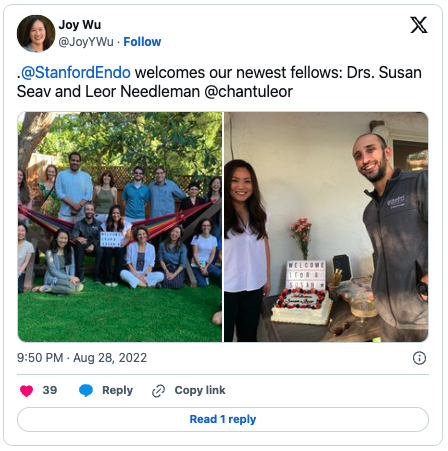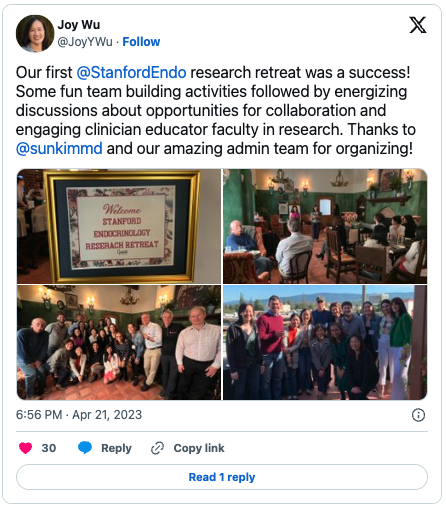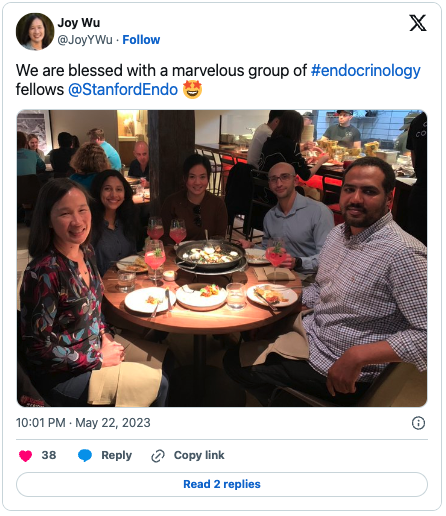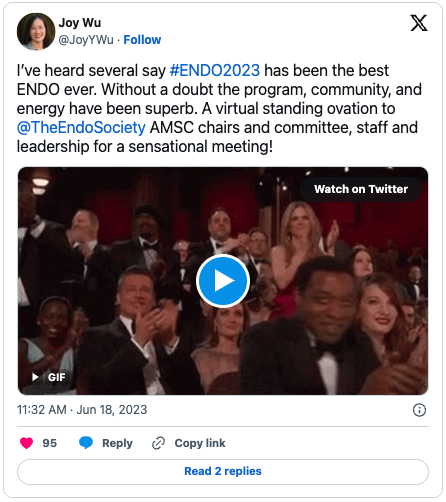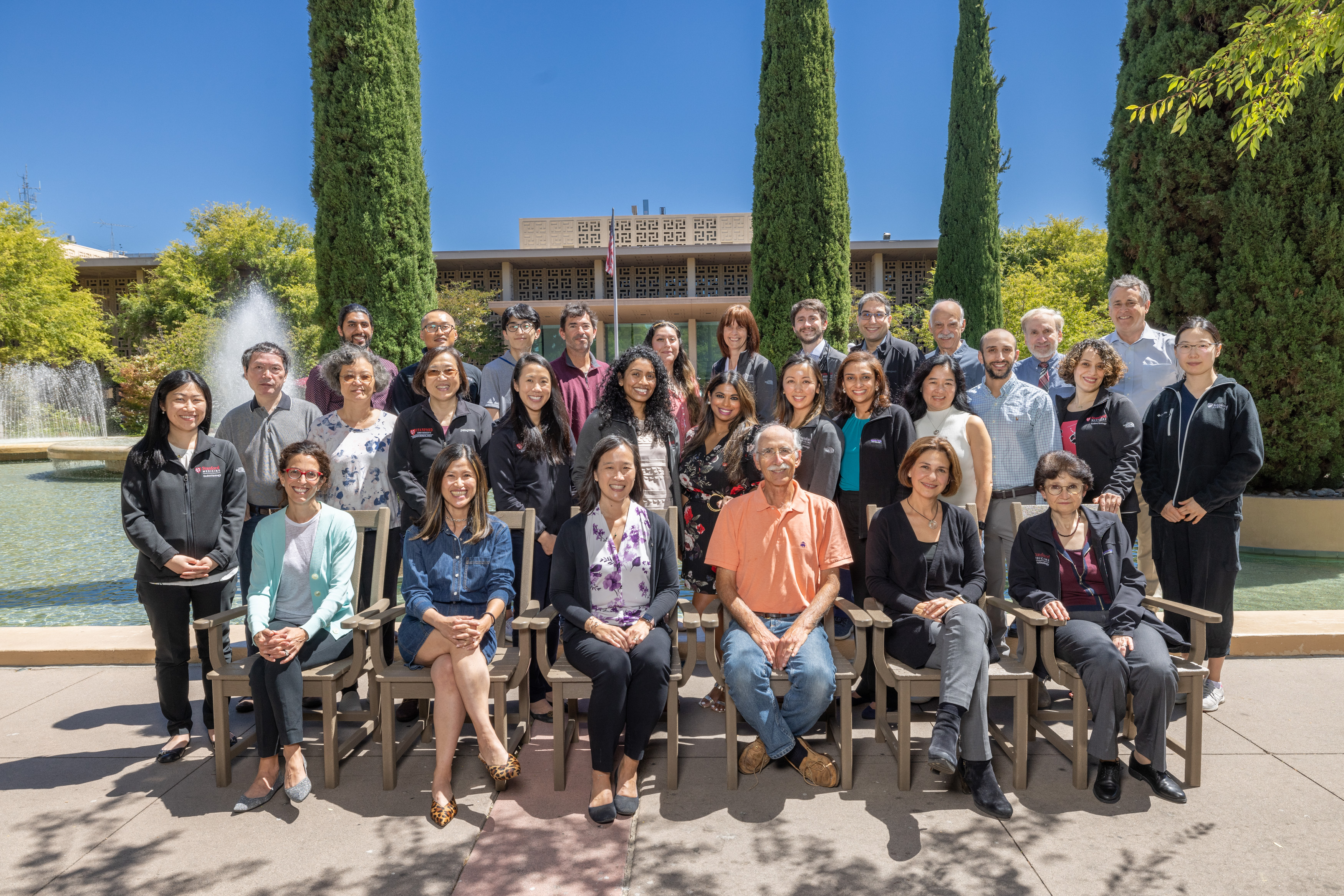
Endocrinology Division’s Mini-Symposium Marks Return to In-Person Events

Endocrinology Division’s Mini-Symposium Marks Return to In-Person Events
In March 2023, the Department of Medicine’s endocrinology division gathered to listen to Justin Annes, MD, PhD, and Rayhan Lal, MD, discuss their laboratories’ current research, challenges, and needs. There were some fascinating revelations during the presentation, but what might have been equally impressive was that the event helped mark the renewal of gatherings in the Department of Medicine.
The presentation was part of the endocrinology division’s inaugural mini-symposium, which sought to catalyze discussions about fascinating science and spur new collaborations both within and outside of the division, says Joy Wu, MD, chief of the division of endocrinology, gerontology and metabolism.
“This was a big initiative within the department with the goal to tackle scientific questions,” says Wu. “We want to sustain and grow research throughout the department.”
During the symposium, Annes, associate professor of endocrinology, discussed how his lab is developing methods to control endocrine cell growth. With this knowledge, the team seeks to uncover novel therapies to prevent and treat disorders of cell growth, including diabetes and hereditary paraganglioma and pheochromocytoma — an inherited tumor syndrome defined by excess cell growth. Lal, assistant professor of endocrinology, is part of the Stanford Diabetes Research Center, where he designs, develops, and tests new technologies and therapies to help people with type 1 diabetes.
Along with offering a space for people to learn about their co-workers’ research, the mini-symposium signaled a turning point. As the COVID-19 pandemic has eased its grip, colleagues within the endocrinology division — and other departments and divisions across the Stanford campus — can once again see each other in person.
“We stayed together as a division by relying on Zoom, but what we lost entirely was the in-person connection — the chatting on the side before and after an event, the ability to quickly check in with people and hear how things are going,” says Wu. “We really missed that, and that’s been the special part about getting back together.”
Many More Meetups to Come
So far this year, these meetups have shown no sign of stopping. Along with the mini-symposium, the endocrinology division has found a variety of ways to congregate.
In April, the endocrinology division gathered for a division mixer with fellows, faculty, and alumni where they chatted about work-life balance, leadership skill development, and professional fulfillment outside of the clinic. The same month, the division hosted their first-ever research retreat full of lively discussions about collaborations and team science.
May marked a retreat for clinical faculty in the endocrinology division, which focused on building on strengths in endocrine clinical care. After years of canceled conferences, societies are also offering in-person meetings and activities once again. This June, the Endocrine Society hosted its annual conference in Chicago, which several Stanford faculty, fellows, and alumni attended. Stanford’s endocrinology division hosted a dinner. On a sunny day in August, members gathered for a division photo — their first one in three years.
Wu and others are looking forward to the many dinners, parties, conferences, and, hopefully, mini-symposiums to come.
“We’re all excited to attend more events and conferences this year,” says Wu. “The ability to share food, drinks, and company in person is something that is so precious, and I think we really missed that over the last couple of years.”
In March 2023, the Department of Medicine’s endocrinology division gathered to listen to Justin Annes, MD, PhD, and Rayhan Lal, MD, discuss their laboratories’ current research, challenges, and needs. There were some fascinating revelations during the presentation, but what might have been equally impressive was that the event helped mark the renewal of gatherings in the Department of Medicine.
The presentation was part of the endocrinology division’s inaugural mini-symposium, which sought to catalyze discussions about fascinating science and spur new collaborations both within and outside of the division, says Joy Wu, MD, chief of the division of endocrinology, gerontology and metabolism.
“This was a big initiative within the department with the goal to tackle scientific questions,” says Wu. “We want to sustain and grow research throughout the department.”
During the symposium, Annes, associate professor of endocrinology, discussed how his lab is developing methods to control endocrine cell growth. With this knowledge, the team seeks to uncover novel therapies to prevent and treat disorders of cell growth, including diabetes and hereditary paraganglioma and pheochromocytoma — an inherited tumor syndrome defined by excess cell growth. Lal, assistant professor of endocrinology, is part of the Stanford Diabetes Research Center, where he designs, develops, and tests new technologies and therapies to help people with type 1 diabetes.
Along with offering a space for people to learn about their co-workers’ research, the mini-symposium signaled a turning point. As the COVID-19 pandemic has eased its grip, colleagues within the endocrinology division — and other departments and divisions across the Stanford campus — can once again see each other in person.
“We stayed together as a division by relying on Zoom, but what we lost entirely was the in-person connection — the chatting on the side before and after an event, the ability to quickly check in with people and hear how things are going,” says Wu. “We really missed that, and that’s been the special part about getting back together.”
Many More Meetups to Come
So far this year, these meetups have shown no sign of stopping. Along with the mini-symposium, the endocrinology division has found a variety of ways to congregate.
In April, the endocrinology division gathered for a division mixer with fellows, faculty, and alumni where they chatted about work-life balance, leadership skill development, and professional fulfillment outside of the clinic. The same month, the division hosted their first-ever research retreat full of lively discussions about collaborations and team science.
May marked a retreat for clinical faculty in the endocrinology division, which focused on building on strengths in endocrine clinical care. After years of canceled conferences, societies are also offering in-person meetings and activities once again. This June, the Endocrine Society hosted its annual conference in Chicago, which several Stanford faculty, fellows, and alumni attended. Stanford’s endocrinology division hosted a dinner. On a sunny day in August, members gathered for a division photo — their first one in three years.
Wu and others are looking forward to the many dinners, parties, conferences, and, hopefully, mini-symposiums to come.
“We’re all excited to attend more events and conferences this year,” says Wu. “The ability to share food, drinks, and company in person is something that is so precious, and I think we really missed that over the last couple of years.”


